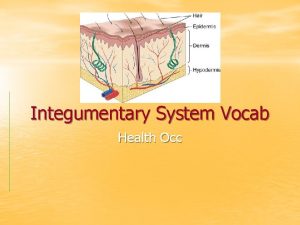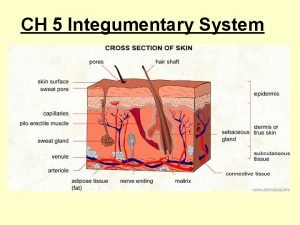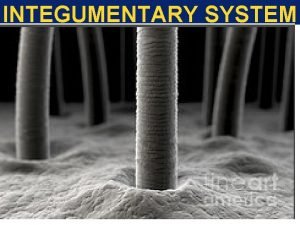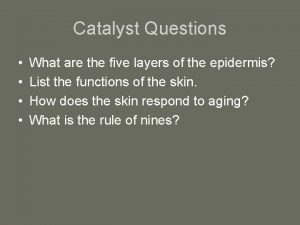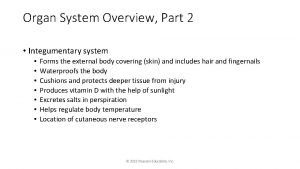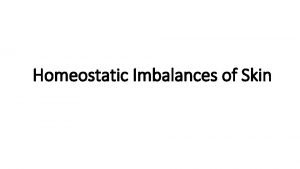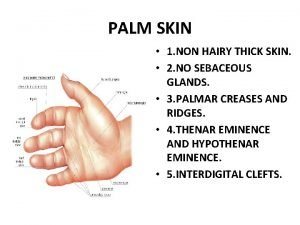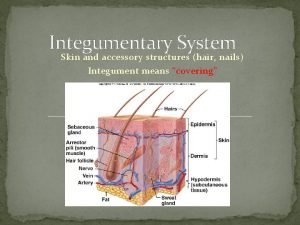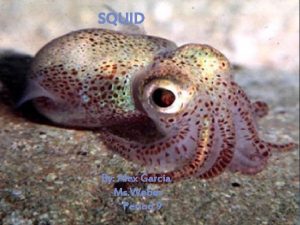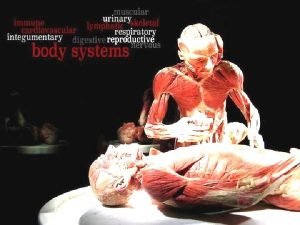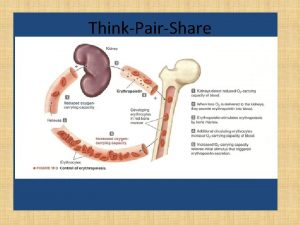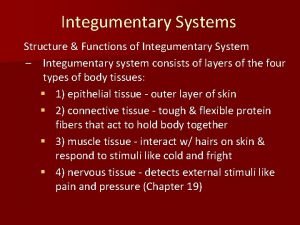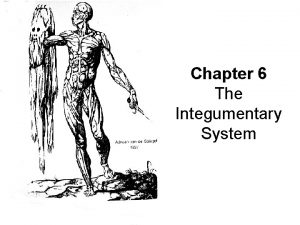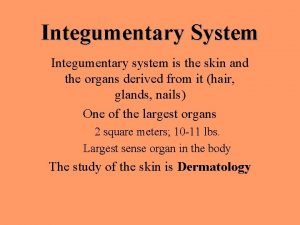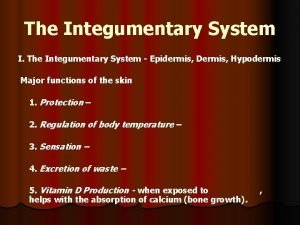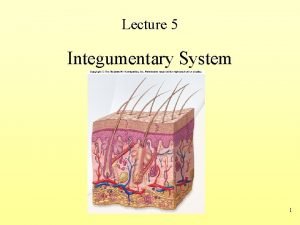The Integumentary System An Introduction to the Integumentary





































![n Hydration ¨ Results from immersion in hypotonic solution (e. g. , freshwater [osmosis]) n Hydration ¨ Results from immersion in hypotonic solution (e. g. , freshwater [osmosis])](https://slidetodoc.com/presentation_image/eda1e8a2dcb212479296a1857e37f5b2/image-38.jpg)






- Slides: 44

The Integumentary System

An Introduction to the Integumentary System n The Integument ¨ Is the largest system of the body n 16% of body weight n 1. 5 to 2 m 2 in area n The integument is made up of two parts 1. Cutaneous membrane (skin) 2. Accessory structures (hair, nails, exocrone glands)

The Integumentary System Integument is skin n Skin and its appendages make up the integumentary system n Two distinct regions of skin n ¨ Epidermis ¨ Dermis ¨ Hypodermis/Subcutaneous Layer

How does this System help other systems? ¨ Cardiovascular n Blood vessels in the dermis ¨ Nervous n system Sensory receptors for pain, touch, and temperature

Functions of skin n Protection ¨ Cushions and insulates and is waterproof ¨ Protects from chemicals, heat, cold, bacteria ¨ Screens UV by producing Melanin n n n Synthesizes vitamin D with UV Regulates body heat Prevents unnecessary water loss Sensory reception (nerve endings) Excretion of salts, water and chemicals Storage of lipids

Epidermis n n Keratinized stratified squamous epithelium Four types of cells Keratinocytes – deepest, produce keratin (tough fibrous protein) ¨ Melanocytes - make dark skin pigment melanin ¨ Merkel cells – associated with sensory nerve endings ¨ Langerhans cells – macrophage-like dendritic cells ¨ n Layers (from deep to superficial) ¨ ¨ ¨ Stratum basale or germinativum – single row of cells attached to dermis; youngest cells; forms fingerprints Stratum spinosum – spinyness is artifactual; tonofilaments (bundles of protein) resist tension Stratum granulosum – layers of flattened keratinocytes producing keratin (hair and nails made of it also) Stratum lucidum (only on palms and soles) Stratum corneum – horny layer (cells dead, many layers thick). Thickest on palms and soles of feet. (see figure on next slide)

Epithelium: layers (on left) and cell types (on right)

5 -1 Epidermis n Stratum germinativum or stratum basale ¨ Forms a strong bond between epidermis and dermis ¨ Forms epidermal ridges (e. g. , fingerprints) ¨ Has many basal cells or germinative cells Thick skin Epidermal ridge

n Specialized Cells of Stratum Basale ¨ Merkel cells n Found in hairless skin n Respond to touch (trigger nervous system) ¨ Melanocytes n Contain the pigment melanin n Scattered throughout stratum basale

n Stratum Spinosum — the “spiny layer” ¨ Produced by division of stratum basale ¨ Cells shrink until cytoskeletons stick out (spiny) ¨ Continue to divide, increasing thickness of epithelium ¨ Contain dendritic (Langerhans) cells, active in immune response

n Stratum Granulosum — the “grainy layer” ¨ Stops n n dividing, starts producing Keratin ¨ A tough, fibrous protein ¨ Makes up hair and nails Keratohyalin ¨ Dense granules ¨ Cross-link keratin fibers

n Stratum Lucidum — the “clear layer” n Found only in thick skin n Covers stratum granulosum

n Stratum Corneum — the “horn layer” n Exposed surface of skin n 15 to 30 layers of keratinized cells n Water resistant n Shed and replaced every 2 weeks

n Keratinization ¨ The formation of a layer of dead, protective cells filled with keratin ¨ Occurs on all exposed skin surfaces except eyes ¨ Skin ¨ It life cycle takes 15– 30 days for a cell to move from stratum basale to stratum corneum

Epidermal Growth Factor (EGF) n n Epidermal Growth Factor (EGF) ¨ Powerful peptide growth factor ¨ Produced by glands (salivary and duodenum) ¨ Used in laboratories to grow skin grafts Functions of EGF ¨ Promotes division of germinative cells ¨ Accelerates keratin production ¨ Stimulates epidermal repair ¨ Stimulates glandular secretion

Remember… n Four basic types of tissue ¨Epithelium – epidermis just discussed ¨Connective tissue - dermis ¨Muscle tissue ¨Nervous tissue

Dermis n n n Strong, flexible connective tissue: your “hide” Cells: fibroblasts, macrophages, mast cells, WBCs Fiber types: collagen, elastic, reticular Rich supply of nerves and vessels Critical role in temperature regulation (the vessels) Two layers (see next slides) ¨ Papillary – areolar connective tissue; includes dermal papillae ¨ Reticular – “reticulum” (network) of collagen and reticular fibers

*Dermis layers *Dermal papillae * *

Epidermis and dermis of (a) thick skin and (b) thin skin (which one makes the difference? )

Fingerprints, palmprints, footprints n n Dermal papillae lie atop dermal ridges Elevate the overlying epidermis into epidermal ridges Are “sweat films” because of sweat pores Genetically determined Flexion creases n Deep dermis, from continual folding Fibers n n Collagen: strength and resilience Elastic fibers: stretch-recoil ¨ n Striae: stretch marks Tension lines (or lines of cleavage) ¨ The direction the bundles of fibers are directed The dermis is the receptive site for the pigment of tattoos

Hypodermis or Subcutaneous Layer n n n “Hypodermis” (Gk) = below the skin “Subcutaneous” (Latin) = below the skin Also called “superficial fascia” “fascia” (Latin) =band; in anatomy: sheet of connective tissue Fatty tissue which stores fat and anchors skin (areolar tissue and adipose cells) Different patterns of accumulation (male/female)

Skin color n n Three skin pigments ¨ Melanin: the most important ¨ Carotene: from carrots and yellow veggies ¨ Hemoglobin: the pink of light skin Melanin in granules passes from melanocytes (same number in all races) to keratinocytes in stratum basale ¨ Digested by lysosomes ¨ Variations in color ¨ Protection from UV light vs vitamin D?

Figure 5 -5 Melanocytes in stratum basale Melanin pigment Basement membrane Melanocytes LM 600

Figure 5 -5 Melanocytes Melanosome Keratinocyte Melanin pigment Melanocyte Basement membrane

n Capillaries and Skin Color ¨ Oxygenated red blood contributes to skin color n Blood vessels dilate from heat, skin reddens n Blood flow decreases, skin pales ¨ Cyanosis n Bluish skin tint n Caused by severe reduction in blood flow or oxygenation

n Illness and Skin Color ¨ Jaundice n n ¨ Pituitary tumor n ¨ Excess MSH Addison’s disease n n ¨ Buildup of bile produced by liver Yellow color A disease of the pituitary gland Skin darkening Vitiligo n n Loss of melanocytes Loss of color

n Vitamin D 3 ¨ Epidermal cells produce (vitamin D 3) n In the presence of UV radiation ¨ Liver and kidneys convert vitamin D 3 into calcitriol n Aids absorption of calcium and phosphorus ¨ Insufficient n vitamin D 3 Can cause rickets

n Function of Melanocytes ¨ Melanin protects skin from sun damage ¨ Ultraviolet n (UV) radiation Causes DNA mutations and burns that lead to cancer and wrinkles ¨ Skin color depends on melanin production, not number of melanocytes

Accessory Structures or Skin appendages Derived from epidermis but extend into dermis n Include n ¨ Hair and hair follicles ¨ Sebaceous (oil) glands ¨ Sweat (sudoiferous) glands ¨ Nails


Hair and hair follicles: complex Derived from epidermis and dermis Everywhere but palms, soles, nipples, parts of genitalia * *“arrector pili” is smooth muscle Hair bulb: epithelial cells surrounding papilla Hair papilla is connective tissue________

n Types of hair ¨ Vellus: fine, short hairs ¨ Intermediate hairs ¨ Terminal: longer, courser n Hair growth: averages 2 mm/week ¨ Active: growing ¨ Resting phase then n hair shed Hair loss ¨ Thinning – age related ¨ Male pattern baldness n Hair color ¨ Amount of melanin for black or brown; distinct form of melanin for red ¨ White: decreased melanin and air bubbles in the medulla ¨ Genetically determined though influenced by hormones and environment

n Functions of hair ¨ Warmth – less in man than other mammals ¨ Sense light touch of the skin ¨ Protection - scalp n Parts ¨ Root imbedded in skin ¨ Shaft projecting above skin surface Make up of hair – hard keratin n Three concentric layers n ¨ Medulla (core) ¨ Cortex (surrounds medulla) ¨ Cuticle (single layers, overlapping)

Nails Of hard keratin n Corresponds to hooves and claws n Grows from nail matrix n

Sebaceous (oil) glands n n n Entire body except palms and soles Produce sebum by holocrine secretion Oils and lubricates

Sweat (sudoriferous) glands n n n Entire skin surface except nipples and part of external genitalia Prevent overheating 500 cc to 12 l/day! (is mostly water) Humans most efficient (only mammals have) Produced in response to stress as well as heat

Types of sweat glands n Eccrine or merocrine ¨ Most numerous ¨ True sweat: 99% water, some salts, traces of waste ¨ Open through pores n Apocrine ¨ Axillary, anal and genital areas only ¨ Ducts open into hair follices ¨ The organic molecules in it decompose with time - odor n Modified apocrine glands ¨ Ceruminous – secrete earwax ¨ Mammary – secrete milk
![n Hydration Results from immersion in hypotonic solution e g freshwater osmosis n Hydration ¨ Results from immersion in hypotonic solution (e. g. , freshwater [osmosis])](https://slidetodoc.com/presentation_image/eda1e8a2dcb212479296a1857e37f5b2/image-38.jpg)
n Hydration ¨ Results from immersion in hypotonic solution (e. g. , freshwater [osmosis]) ¨ Causes swelling of epithelial cells, evident on the palms and soles

Disorders of the integumentary system n Burns ¨ Threat to life n Catastrophic loss of body fluids n Dehydration and fatal circulatory shock n Infection ¨ Types n First degree – epidermis: redness (e. g. sunburn) n Second degree – epidermis and upper dermis: blister n Third degree - full thickness Infections n Skin cancer n

Burns First-degree (epidermis only; redness) Second-degree (epidermis and dermis, with blistering) Third-degree (full thickness, destroying epidermis, often part of hypodermis)

Critical burns n n n Over 10% of the body has thirddegree burns 25 % of the body has seconddegree burns Third-degree burns on face, hands, or feet Estimate by “rule of 9’s”

Tumors of the skin Benign, e. g. warts n Cancer – associated with UV exposure (also skin aging) n ¨ Aktinic keratosis - premalignant ¨ Basal cell - cells of stratum basale ¨ Squamous cell - keratinocytes ¨ Melanoma – melanocytes: most dangerous; recognition: A - Asymmetry n B - Border irregularity n C - Colors n D - Diameter larger than 6 mm n

Skin Cancer Sqaumous cell carcinoma Basal cell carcinoma Melanoma

Figure 5 -6 Skin Cancers Basal cell carcinoma Melanoma
 Cutaneous membrane
Cutaneous membrane Integumentary system vocabulary
Integumentary system vocabulary Integumentary system fetal pig
Integumentary system fetal pig Integumentary system adalah
Integumentary system adalah Epidermis layers
Epidermis layers The integumentary system exercise 7
The integumentary system exercise 7 Integumentary system abbreviations
Integumentary system abbreviations Exfoliative dermatitis
Exfoliative dermatitis The integumentary system
The integumentary system Integumentary system physical examination
Integumentary system physical examination Excretory system analogy
Excretory system analogy Cat integumentary system
Cat integumentary system The integumentary system
The integumentary system Integumentary system components
Integumentary system components Integumentary system effects of aging
Integumentary system effects of aging Section 36-3 the integumentary system
Section 36-3 the integumentary system Integumentary system
Integumentary system Integumentary system
Integumentary system Unit 3 integumentary system a&p chapter 5
Unit 3 integumentary system a&p chapter 5 Skin homeostatic imbalance
Skin homeostatic imbalance Cells in stratum spinosum
Cells in stratum spinosum 6 functions of the integumentary system
6 functions of the integumentary system Anatomy and physiology of psoriasis
Anatomy and physiology of psoriasis Interesting facts about the integumentary system
Interesting facts about the integumentary system Integumentary system
Integumentary system Integumeny
Integumeny Integumentary system cpt coding guidelines ppt
Integumentary system cpt coding guidelines ppt Stratum basale
Stratum basale Integumentary system of vertebrates
Integumentary system of vertebrates Nails integumentary system
Nails integumentary system Integumentary system
Integumentary system Excretory and integumentary system
Excretory and integumentary system Squid integumentary system
Squid integumentary system Skeletal system foldable
Skeletal system foldable Chapter 6 integumentary system
Chapter 6 integumentary system Chapter 36 skeletal muscular and integumentary systems
Chapter 36 skeletal muscular and integumentary systems Meissner corpuscle
Meissner corpuscle How to pronounce integumentary
How to pronounce integumentary Organization of the lymphatic system
Organization of the lymphatic system Hình ảnh bộ gõ cơ thể búng tay
Hình ảnh bộ gõ cơ thể búng tay Bổ thể
Bổ thể Tỉ lệ cơ thể trẻ em
Tỉ lệ cơ thể trẻ em Voi kéo gỗ như thế nào
Voi kéo gỗ như thế nào Tư thế worm breton là gì
Tư thế worm breton là gì






